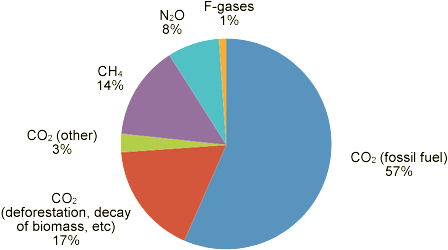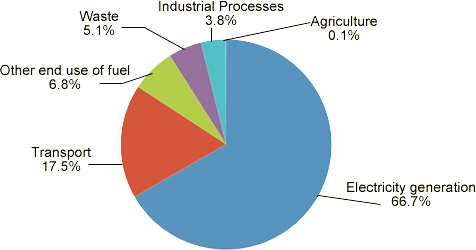ENERGY
The greenhouse gases
Greenhouse gases(GHG)are the gases in atmosphere that can absorb and emit radiation and heat. This process is the fundamental cause of the greenhouse effect. In the Earth's atmosphere, the primary greenhouse gases are carbon dioxide, methane, nitrous oxide and fluorinated gases. When sunlight strikes the Earth's surface, some reflected as infrared radiation (heat). Greenhouse gases tend to absorb this infrared radiation as it is reflected back towards space, trapping the heat in the atmosphere. Studies show that the GHG emissions due to human activities have grown since pre-industrial times, with an increase of 70% between 1970 and 2004.
Global GHG Emission

GHG Emission in Hong Kong, China by Sector in 2008

Some greenhouse gases occur naturally in the atmosphere, while others are generated as a result of human activities. The following briefly describes the major GHG.
- Carbon Dioxide (CO2): A variety of human activities lead to the emission of carbon dioxide. Among these, the largest sources are the combustion of fossil fuels such as coal, oil and natural gas for power generation, transportation and industrial manufacturing processes.
- Methane (CH4): Methane is emitted from a variety of both human-related and natural sources. It is estimated that about half of global methane emissions are caused by human-related activities which mainly include fossil fuel production, rice cultivation, biomass (e.g. wood) burning and waste management in landfills.
- Nitrous Oxide (N2O): The increased emission of nitrous oxide in the atmosphere is also related to human activities. The main human-related sources of nitrous oxide are agricultural and industrial processes, as well as combustion of fossil fuels and solid waste.
- Fluorinated Gases: Fluorinated gases, different from other greenhouse gases, are the only type of greenhouse gas that is totally created and emitted by human activities. Fluorinated gases are emitted upon production and/or usage of refrigerants, foams and aerosols.
Kyoto Protocol
The Kyoto Protocol of UNFCCC (United Nations Framework Convention on Climate Change) is a comprehensive multinational effort to mitigate the issue of global warming, which was adopted in Kyoto, Japan, on 11 December 1997. Its main purpose is to set binding targets for 37 industrialized countries and the European community to reduce greenhouse gas (GHG) emissions.
Kyoto Protocol commits industrialised countries (as a group) to reduce domestic emissions by about 5% relative to 1990 by the first commitment period of 2008-12. Kyoto Protocol also permits that industrialised countries to transfer and earn emission credits by participating emissions reduction projects of developing countries.
Copenhagen Accord
In 2009, The United Nations Climate Change Conference, commonly known as the Copenhagen Summit, was held in Copenhagen. After two weeks of negotiations, world leaders delivered a three-page non-binding political declaration (‘Copenhagen Accord’) that fails to provide a successor to the Kyoto Protocol (expiring in 2012). The joint statement mentions that global emissions must be reduced ‘so as to hold the increase in global temperature to below 2°C’.
References:
- [1] The NOAA Annual Greenhouse Gas Index
- [2] Climate Change – Greenhouse Gas Emissions, USEPA
- [3] Nitrous Oxide, USEPA
- [4] Climate Change 2007 Synthesis Report
- [5] Emission of Greenhouse Gases in US 2008 by US Energy Information Administration, office of Integrated Analysis and Forecasting, US Department of Energy